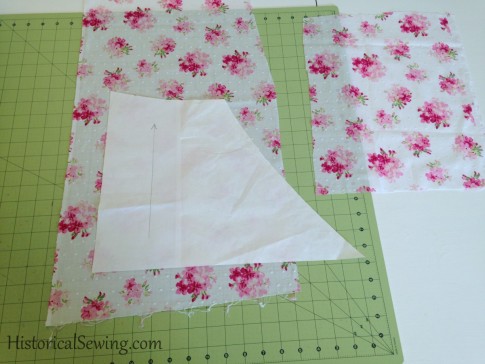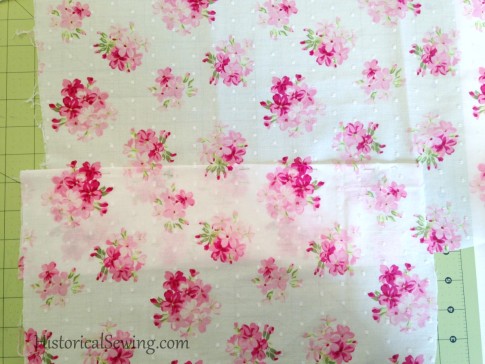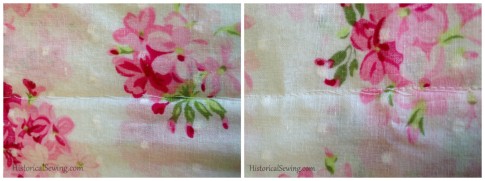
So you only bought seven yards. You need eight. Of course. Because you didn’t check the yardage listing before you went shopping or the store only had the seven.
But you’re determined to make the dress anyway….
When you’re a bit short on fabric, the [historically accurate] method of Making It Work is to piece the fabric. Here’s how:

Piecing is simply sewing two lengths of fabric together to make one larger piece of material in which to cut pattern shapes that don’t fit on the one width. The two lengths can be sewn either vertically or horizontally depending on your particular garment project.
Piecing itself occurs in areas where the pattern is too large for a narrow bit of fabric. This is generally near the hems of skirt panels, wide sleeves (like the gigantic shapes of the 1830s and 1890s), and longer bodices where the bottom hem is fairly wide to cover full hips. Trains are notorious users of the piecing method. As are full length capes and cloaks.
But it’s not just main garments that may need piecing. Period chemise undergarments were often pieced at the lower side seams so as to provide enough hem width for wearing comfort but still keeping within the narrow cloth selvedges.
Most any garment can be constructed with piecing. However, when you need to piece, keep the seams in areas that will be less visually noticeable or will be covered with trims.
Important note: with piecing, cut the added patches of fabric on the same grain as the garment piece you are sewing to.
For more in-depth piecing of fabric panels use this tutorial:

Lay the larger panel of fabric on the table. Following the same grain, overlap the piecing panel on top and match any stripe, pattern or plaid. Fold under the raw edge of the top piece.


Slipstitch the top fabric to the main panel by running the needle through the fold of the top piece and picking up a few threads of the main panel. You’re simply basting the two pieces together here.

Fold back the top panel and machine stitch this piecing seam following your slipstitch threads.
Press seam flat then press open.

If this piecing seam will not be enclosed or hidden by facings or linings, finish the raw edges with pinking or light hand overcast stitches to prevent fraying. If your fabric in prone to fraying, I’d suggest finishing the edges even if they will be turned to the inside of the garment.

Lay out your pattern on the now-bigger fabric area and cut out. Treat the cut fabric piece as one during the rest of construction.
As selvedges are stiff and more tightly woven than the rest of the material, it’s not advisable to use them in your piecing seams. In other words, don’t use the straight selvedge edge to sew to the main fabric piece. Cut off the selvedge first then sew together.
Have you pieced fabric before in garment sewing? Any particular projects you’re proud of?


I have several old kimonos (unstitched, during the shutdown) and kimono fabrics that I intend to make into Western-style clothing. Most of them will require piecing.
What I noticed when unstitching the first batch of kimonos was that the seams were set back about 3 cm from the selvage, then sewn, and I wonder if that will work – sewing 2 selvages together might work in a lining where the fabric is short, but I may need to “waste” 6cm (3cm x 2) on each area of piecing.
Since each kimono was lined, I now also have matching solid light silk fabric for every heavier silk or wool/silk outer fabric from the kimonos. I’m pondering linings vs blouses for that fabric.
One of the kimonos, lovely as not needing to have any pattern matched, was more badly damaged than it had appeared to be in the store. I think I am going to use that for the second trial of the pattern I’ve selected.
Ooh, how lovely to sew with vintage kimonos! Even if you are having to piece considerably. Is there too much of a “permanent” press/seam line where they used a wide seam allowance at the selvedges to piece and not waste the width?
I just this today with some lining I needed to piece together. Thanks for the tutorial!
You’re welcome, Sierra!
I wish I could post pictures – I just got to examine a dress, circa 1845, in an archive. The maker didn’t have quite enough fabric to match the striped sheer cotton, so nearly every pattern piece in the bodice has been pieced in some odd place! There’s a little join nipping off a corner of each of the bodice front pieces at the shoulder seam, a big horizontal join across one of the back pieces, a join that looks like an odd extra seam in one of the side pieces . . . five in all. Either it was her first time matching stripes and she cut the pieces out all wrong (I would do no better myself!), or she was determined to make the dress despite running out of fabric. Ingenuity!
Wow! Sounds very interesting.
what if you have to piece thicker fabric like Matelasse?
I don’t think it would be much different. You would still baste the fold on the right side of the fabric; however, you may need to mark that line somehow on the back to follow when permanently machine stitching the two fabric pieces together.
Glad to see my “MacGyver” sewing moments — always due to some boneheaded maneuver on my part — have a bit of historical accuracy. LOL. Thanks, Jennifer!
I had to piece last year when I made an 1890s-inspired steampunk outfit. Because I had bought the fabrics from the discount bin, I ended up short on the fabric for the bustle, and because the satin-backed shantung I used for the jacket had a distressing tendency to fray, I ended up flatlining the body of the bustle with a pieced-together layer of the skirt fabric. You can see the results here.